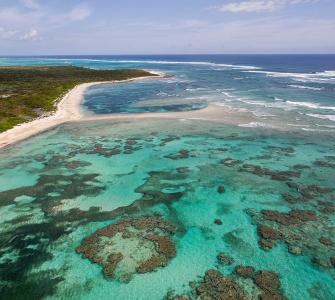Coral Reef Conservation
Coral reefs are an integral part of coastal ecosystems, home to incredible biodiversity, and provide a range of valuable services to people and local economies, such as flood protection, tourism, and a source of fish and medicine. However, these valuable reefs face a myriad of threats including climate related impacts, overfishing, declining water quality, pollution, and extreme weather events. Extreme weather events can cause physical damage to coral reefs as strong waves and currents can break or overturn coral colonies, causing fragmentation and destruction of the reef structure.
When reef systems are threatened by extreme weather events it is often difficult to justify investment in their restoration, especially when many of the economic services provided by coral reefs are not fully recognized and often underestimated. CSF’s work highlights the importance of the economic services provided by natural systems like coral reefs, and builds an economic case for investing in conservation and restoration efforts.
Working with The Nature Conservancy
Our partners at The Nature Conservancy (TNC) are working with the government of the Bahamas to protect their natural resources and adapt to the threats caused by climate change. Conservation Strategy Fund (CSF) contributed to this work by providing economic justification for the island nation to invest in coral reef restoration, as social and economic losses associated with coral reef damage greatly surpass the cost of restoration.
Results: Restore the Reef!
CSF completed an economic valuation and cost-benefit analysis to build a business case for repairing coral reefs after a hurricane and to identify possible financing mechanisms that can be used to finance the cost of repairing.
Results show that the social and economic losses surpass the cost of repairs, and that certain financial tools can keep costs low while benefiting the local economy with a booming tourism industry and healthier coastal ecosystems.
Key Takeaways:
- For each 1% decrease in coral due to storms, annual tourism visitation decreases by 0.03% in the next two years after the event.
- It is socially and financially profitable for the Government of the Bahamas to invest in coral reef restoration after storm events, even if the storm events are not high-impact.
- Reef restoration investment leads to avoided losses in tourism and fisheries; avoided job losses in both sectors; and avoided tax collection reduction from tourism.
- Insurance will be the most cost-effective financial mechanism to support the Bahamas in their reef restoration.
- CSF designed a new model to understand the economic consequences of coral reef damage that can be applied to other coastal communities to justify coral reef restoration efforts after storm events.
What is next for coral reefs in the Bahamas?
CSF’s analysis demonstrated significant net gains from coral reef restoration and proved that under the lowest premium payment, an insurance plan can cover much of the costs of reparation. We hope that with this valuable information, the Government of the Bahamas will not hesitate to purchase insurance for coral reef restoration after storms.
Investing in reef restoration efforts is not only cost-effective, but as the CSF study demonstrates, the social and economic benefits of reestablishing a healthy coral reef ecosystem for tourism, fishing, food and recreation etc. far surpass the costs of restoration.
Methodology
In order to perform this assessment, CSF designed a new economic tool to quantify the relationship between tourism flows in the Bahamas and coral reef damage due to storms. There was no existing data on this relationship, so CSF Senior Economist Adriana Chacón-Cascante designed a modified gravitational model that can be replicated for use by other coastal nations to demonstrate the relationship between tourism and coral reef damage.
This economic analysis:
- estimated economic losses associated with reef damage caused by a storm in the tourism and fisheries sectors;
- provided a cost-benefit analysis of post-storm response action; and
- provided a cost-benefit analysis of alternative financing mechanisms.
Various valuation and costing methods were used to estimate the necessary costs and benefits for the different analyses. For instance, to measure the impact of coral reefs damage from storms on the tourism sector, a gravitational model was estimated using econometrics techniques and historical data on visitation were later used. For the fisheries industry, projections were done on how much coral reef coverage affects biomass and fisheries productivity; then historical market structures were used to model the possible impacts on the industry. To make the results more robust, three scenarios of coral reef damages from storms were analyzed.
—
This project was conducted in partnership with The Nature Conservancy. For interviews or further questions, please contact [email protected].
Photo: Cat Island, The Bahamas
Photo Credit: Shutterstock.com

